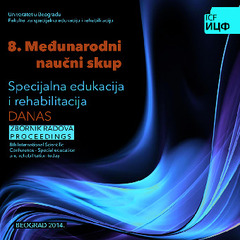Zlostavljanje starih osoba – teškoće u otkrivanju i smernice za intervencije
Elder abuse – difficulties in detection and guidelines for intervention
| dc.contributor | Vuković, Mile | |
| dc.contributor | Kovačević, Jasmina | |
| dc.contributor | Maćešić-Petrović, Dragana | |
| dc.creator | Radulović, Danka | |
| dc.date.accessioned | 2022-03-22T12:28:54Z | |
| dc.date.available | 2022-03-22T12:28:54Z | |
| dc.date.issued | 2014 | |
| dc.identifier.isbn | 978-86-6203-061-0 | |
| dc.identifier.uri | http://rfasper.fasper.bg.ac.rs/handle/123456789/4256 | |
| dc.description.abstract | Zlostavljanje starih sve je prisutnije u društvima u čijoj strukturi raste udeo pojedinaca starijih od 65 god. marginalizovanih vrednosnim diktatom protiv starenja i imperativom da se društvene uloge i pozicije dodeljuju u mladalaštvu. Za razliku od zlostavljanja dece, empirijska građa o zlostavljanju starih uopšte veoma je skromna, a pogotovu o ključnom aspektu koji se tiče relacija među bliskim srodnicima i davaocima i primaocima izdržavanja na koje se fokusira ovaj rad. Teškoće u naučnom istraživanju zlostavljanja starih su brojne: od razlika u polaznim definicijama koje se uglavnom odnose na neke od aspekata fizičkog, psihičkog, ekonomskog ili seksualnog zlostavljanja i zanemarivanja, te razlika u poimanju prirode fenomena, a s tim u vezi nekomparabilnih grupa proučavanih u okviru studija; do različitih mera ishoda zlostavljanja. Nemogućnost pribavljanja slučajnih uzoraka ove kategorije žrtava i zlostavljača poseban je istraživački problem koji usložnjavaju visoke tamne brojke zbog prikrivene prirode ovog oblika zlostavljanja. Još je teži problem iznalaženje načina da se ostvare efikasne intervencije u ovom domenu. U radu su na osnovu raspoložive naučno-empirijske građe prikazana najčešća teorijska objašnjenja fenomena zlostavljanja starih, izdvojene su varijable koje čine faktore rizika, a tiču se kako žrtava tako i aktera zlostavljanja, kao i miljea u kome se ono dešava i ukazano je na teškoće u detekciji zlostavljanja zbog kojih su tamne brojke visoke. Na osnovu toga koncipiran je okvir za identifikaciju i ispitivanje i moguće intervencije koje bi predupredile povrat, a koje obuhvataju i žrtve i zlostavljače. | sr |
| dc.description.abstract | Elder abuse is more present in societies which have a growing population of people older than 65 who are marginalized through the dictation of values that confront ageing and through the imperative that social roles and positions are granted in youth. Unlike child abuse, there is insufficient empirical data on elder abuse, specifically when it comes to the key aspect which considers relations between close relatives and caregivers, which will be the focus of the paper. There are several difficulties in elder abuse research: differences in initial definitions which are related to aspects of physical, psychological, economic or sexual abuse and neglect; differences in the understanding of the phenomenon nature; incomparable groups that are examined in studies; different outcomes of the abuse. Random sampling for this category of victims and molesters is a specific problem and the “dark figure“ for the hidden nature of this form of abuse makes this problem even more complex. Finding solutions for effective intervention against this type of abuse is also a big issue in this area. Based on the existing empirical data, the paper shows most often theoretical explanations for elder abuse phenomenon. Risk factors variables are presented with respect to victims and molesters. The context of the abuse and difficulties in detecting molesters, which affect high rate of the “dark figure“ are also analyzed. A framework for identification, examining and possible intervention, that are targeted at both victims and molesters, is created, and it could prevent recidivism. | sr |
| dc.language.iso | sr | sr |
| dc.publisher | Univerzitet u Beogradu – Fakultet za specijalnu edukaciju i rehabilitaciju/ University of Belgrade – Faculty of Special Education and Rehabilitation | sr |
| dc.relation | info:eu-repo/grantAgreement/MESTD/Integrated and Interdisciplinary Research (IIR or III)/47008/RS// | sr |
| dc.relation | info:eu-repo/grantAgreement/MESTD/Integrated and Interdisciplinary Research (IIR or III)/47011/RS// | sr |
| dc.rights | openAccess | sr |
| dc.rights.uri | https://creativecommons.org/licenses/by-sa/4.0/ | |
| dc.source | Zbornik radova - 8. Međunarodni naučni skup „Specijalna edukacija i rehabilitacija danas“, Beograd, Srbija, 7-9. 11. 2014 | sr |
| dc.subject | zlostavljanje | sr |
| dc.subject | stari | sr |
| dc.subject | rizici | sr |
| dc.subject | tamne brojke | sr |
| dc.subject | intervencije | sr |
| dc.subject | abuse | sr |
| dc.subject | elder | sr |
| dc.subject | risks | sr |
| dc.subject | “dark figure“ | sr |
| dc.subject | interventions | sr |
| dc.title | Zlostavljanje starih osoba – teškoće u otkrivanju i smernice za intervencije | sr |
| dc.title | Elder abuse – difficulties in detection and guidelines for intervention | sr |
| dc.type | conferenceObject | sr |
| dc.rights.license | BY-SA | sr |
| dc.citation.epage | 209 | |
| dc.citation.spage | 187 | |
| dc.identifier.fulltext | http://rfasper.fasper.bg.ac.rs/bitstream/id/6680/Untitled22.pdf | |
| dc.identifier.rcub | https://hdl.handle.net/21.15107/rcub_rfasper_4256 | |
| dc.type.version | publishedVersion | sr |


